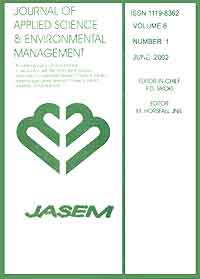
|
Journal of Applied Sciences and Environmental Management
World Bank assisted National Agricultural Research Project (NARP) - University of Port Harcourt
ISSN: 1119-8362
Vol. 22, No. 5, 2018, pp. 713-717
|
 Bioline Code: ja18124
Bioline Code: ja18124
Full paper language: English
Document type: Research Article
Document available free of charge
|
|
|
Journal of Applied Sciences and Environmental Management, Vol. 22, No. 5, 2018, pp. 713-717
| en |
Isolation, Modification and Characterization of Tiger-Nut, Maize, Cassava and Potato Starch
AZEH, Y; PAIKO, YB; ABUBAKAR, AY; GARBA, B & AMEH, OAE
Abstract
Four different sources of starchy foods were used for the isolation of starch using commercially cheap
and readily available chemical-hypo (3.5 % active Chlorine). The isolated starch was modified through NaIO4 oxidation
under mild reaction conditions. Carbonyl functional group test was employed for confirmation of the success of oxidation.
FT-IR and Scanning Electron Microscopy (SEM) were used for functional group identification and morphological
examination of both modified and native samples to further confirm the success of modification. The appearance of the
carbonyl band at 1747-1746 cm-1 and 1647 – 1637 cm-1 indicated the successful synthesis of oxidized starch. Proximate
results showed that the isolated starches were rich in mineral content: 0.25-2.13; crude fibre: 0.85-3.31; fat: 0.23-0.28 and
energy: 1331-1410. The study showed that commercial hypo could be a useful replacement for metabisulphite for starch
isolation without side effects on starch properties. SEM images showed that morphological architecture of granules was
not destroyed during surface functionalization. Characteristic and nutritional features of the oxidized starch showed that
it could find useful applications in food and pharmaceutical industries.
Keywords
Tiger-nut; Maize; Cassava; Potato; Modification
|
| |
© Copyright 2018 - Azeh et al.
|
|
